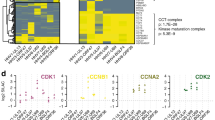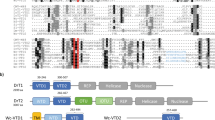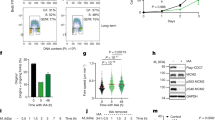Abstract
CYCLINS are regulatory subunits which associate with kinases to form complexes that control many of the important steps in cell-cycle progression. The best characterized of the cyclin-containing complexes is the association of cyclin B with the p34cdc2 kinase. The p34cdc2/cyclin B complex is required for the G2 to M transition (see refs 1–4 for review), but the physiological role of other cyclin complexes is unclear. Human cyclin A binds independently to two kinases, associating with either p34cdc2 or a related protein, p33 (refs 5–7). In adenovirus-transformed cells, the viral E1 A oncoprotein seems to associate with p33/cyclin A but not with P34cdc2/cyclin A (B. Faha, M.M., L-H.T. and E.H., manuscript submitted). To isolate the gene for p33, we have cloned several novel human cdc2-related genes. The protein product of one of these genes, cdk2 (cyclin-dependent kinase 2), shares 65% sequence identity with p34cdc2 (ref. 8) and 89% identity with the Xenopus Eg-1 gene product9. Immmunochemical characterization and partial proteolytic mapping show that the cdk2 gene product is the cyclin A-associated p33. Immunoprecipitations of the p33cdk2 protein suggest that it can act as a protein kinase in vitro. As p33cdk2 is bound to cyclin A and is targeted by the viral El A protein, we suggest that the p33cdk2/cyclin A complex has a unique role in cell-cycle regulation of vertebrate cells.
This is a preview of subscription content, access via your institution
Access options
Subscribe to this journal
Receive 51 print issues and online access
$199.00 per year
only $3.90 per issue
Buy this article
- Purchase on Springer Link
- Instant access to full article PDF
Prices may be subject to local taxes which are calculated during checkout
Similar content being viewed by others
References
Murray, A. W. & Kirschner, M. W. Science 246, 614–621 (1989).
Nurse, P. Nature 344, 503–508 (1990).
Pines, J. & Hunter, T. New Biol. 2, 389–401 (1990).
Draetta, G. Trends biochem. Sci. 15, 378–383 (1990).
Giordano, A. et al. Cell 58, 981–990 (1989).
Pines, J. & Hunter, T. Nature 346, 760–763 (1990).
Giordano, A. et al. Science (in the press).
Lee, M. G. & Nurse, P. Nature 327, 31–35 (1987).
Paris, J. et al. Proc. natn. Acad. Sci. U.S.A. 88, 1039–1043 (1991).
Draetta, G. & Beach, D. Cell 54, 17–26 (1988).
Harlow, E., Whyte, P., Franza, B. R. Jr & Schley, C. Molec. cell. Biol. 6, 1579–1589 (1986).
Lehner, C. F. & O'Farrell, P. EMBO J. 9, 3573–3581 (1990).
Saiki, R. K. et al. Science 230, 1350–1354 (1985).
Hanks, S. K., Quinn, A. M. & Hunter, T. Science 241, 42–52 (1988).
Krek, W. & Nigg, E. A. EMBO J. 10, 305–316 (1991).
Gould, K. L. & Nurse, P. Nature 342, 39–45 (1989).
Arion, D., Meijer, L., Brizuela, L. & Beach, D. Cell 55, 371–378 (1988).
Langan, T. A. et al. Molec. cell. Biol. 9, 3860–3868 (1989).
Elledge, S. J. & Spottswood, M. R. EMBO J. 10 2653–2660 (1991).
Ninomiya-Tsuji, J., Nomoto, S., Yasuda, H., Reed, S. I. & Matsumoto, K. Proc. natn. Acad. Sci. U.S.A. (in the press).
Nurse, P. & Bissett, Y. Nature 292, 558–560 (1981).
Piggott, J., Rai, R. & Carter, B. Nature 298, 391–393 (1982).
Bellett, A. J. D. et al. Molec. cell. Biol. 5, 1933–1939 (1985).
Stabel, S., Argos, P. & Philipson, L. EMBO J. 4, 2329–2336 (1985).
Kaczmarek, L., Ferguson, B., Rosenberg, M. & Baserga, R. Virology 152, 1–10 (1986).
Graham, F. O., Smiley, J., Russell, W. & Nairn, R. J. gen. Virol. 36, 59–72 (1977).
Harlow, E., Crawford, L., Pim, D. & Williamson, N. J. Virol. 39, 861–869 (1981).
Harlow, E., Franza, B. R. Jr & Schley, C. J. Virol. 55, 533–546 (1985).
Whyte, P. et al. Nature 334, 124–129 (1988).
Sanger, F., Nicklen, S. & Coulson, A. R. Proc. natn. Acad. Sci. U.S.A. 74, 5463–5467 (1977).
Lane, D. P. & Robbins, A. K. Virology 87, 182–193 (1978).
Cleveland, D. W., Fischer, S. G., Kirschner, M. W. & Laemmli, U. K. J. biol. Chem. 252, 1102–1106 (1977).
Smith, D. B. & Johnson, K. S. Gene 67, 31–40 (1988).
Buchkovich, K., Duffy, L. A. & Harlow, E. Cell 58, 1097–1105 (1989).
Hermann, C. H., Su, L.-K., Whyte, P., Buchkovich, K. & Harlow, E. J. Virol. (in the press).
Author information
Authors and Affiliations
Rights and permissions
About this article
Cite this article
Tsai, LH., Harlow, E. & Meyerson, M. Isolation of the human cdk2 gene that encodes the cyclin A- and adenovirus E1A-associated p33 kinase. Nature 353, 174–177 (1991). https://doi.org/10.1038/353174a0
Received:
Accepted:
Issue Date:
DOI: https://doi.org/10.1038/353174a0
This article is cited by
-
Ensemble learning from ensemble docking: revisiting the optimum ensemble size problem
Scientific Reports (2022)
-
FMR1NB Involved in Glioma Tumorigenesis Is a Promising Target for Prognosis and Therapy
Current Medical Science (2022)
-
Immunomodulation by anticancer cell cycle inhibitors
Nature Reviews Immunology (2020)
-
Cosolvent Analysis Toolkit (CAT): a robust hotspot identification platform for cosolvent simulations of proteins to expand the druggable proteome
Scientific Reports (2019)
-
The alpha-fetoprotein (AFP) third domain: a search for AFP interaction sites of cell cycle proteins
Tumor Biology (2016)
Comments
By submitting a comment you agree to abide by our Terms and Community Guidelines. If you find something abusive or that does not comply with our terms or guidelines please flag it as inappropriate.



